|
Janam XT2
Ultra-rugged touch computer for those who need business-class performance, durability and flexibility in a smartphone-like design
By Conrad H. Blickenstorfer; photography by Carol Cotton; see full PDF reprint
Share on:




When Janam introduced the Janam XT2 in late Spring 2016, the company called it "the industry's toughest and lightest ultra-rugged touch computer." Janam's goal with the tough, elegant and handy device was to provide business-class performance, durability and flexibility in a smartphone-like Android design, one that would be joined in Fall 2016 by a Windows 10 IoT Mobile Enterprise version. RuggedPCReview had the opportunity to spend a few weeks with the Android model of the Janam XT2. This report presents our review and observations.

As the picture above shows, Janam did a remarkable job in making the XT2 look just like a friendly, trendy smartphone, nicely clad in some protective gear. And that's really the point here: with all those hundreds of millions of smartphones out there, most people simply expect a handheld computer to be just like their personal phone. They already know how that works. They're not afraid.
The challenge with this approach, of course, is to really pull it off. If a device looks like a state-of-the-art smartphone but can't back up the snazzy look with the specs and tech consumers expect, it'll be dismissed as an expensive pretender. If it does deliver the goods but is just too big and heavy, again, it won't go far. So the challenge is to come up with something that has that appealing consumer tech look and feel, but also adds enough serious tool-for-the-job value to make enterprise users accept whatever extra heft and cost there is as natural and logical.
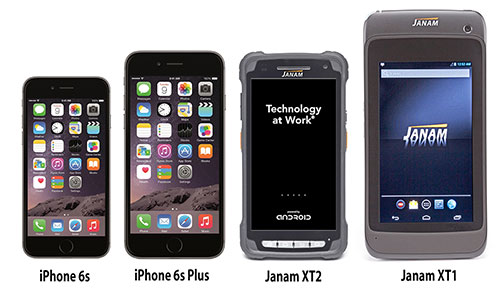 With that in mind, let's take a look at the Janam XT2. It has a 6.1 x 3.2 inch footprint, which is almost exactly that of the Apple iPhone 7 Plus. It can make that footprint magic possible despite the tough-looking protective perimeter armor because its display is a bit smaller — 5.0 inches diagonal versus the big iPhone's 5.5 inches. With that in mind, let's take a look at the Janam XT2. It has a 6.1 x 3.2 inch footprint, which is almost exactly that of the Apple iPhone 7 Plus. It can make that footprint magic possible despite the tough-looking protective perimeter armor because its display is a bit smaller — 5.0 inches diagonal versus the big iPhone's 5.5 inches.
The comparison picture on the right shows where the Janam XT2 fits in sizewise. Starting on the left, the 4.7-inch display of the Apple iPhone 6s would have been considered huge only a few years ago, certainly much larger than the 2.8 to 3.5-inch displays used for many years on virtually all phones, Pocket PCs and industrial handhelds.
Next, the iPhone 6s Plus with its 5.5 inch screen redefined the smartphone market. Large-screen phones had been available before, but were primarily viewed as efforts to somehow differentiate themselves from the iPhone. The iPhone 6 Plus established the big-screen smartphone as a universal small computer that was neither just a phone nor a small tablet, but somehow more than the sum of their parts. And that is exactly where the 5-inch Janam XT2 fits in sizewise. On the right, for comparison, the Janam XT2 with its 5.9-inch screen is already in the mini-tablet territory.
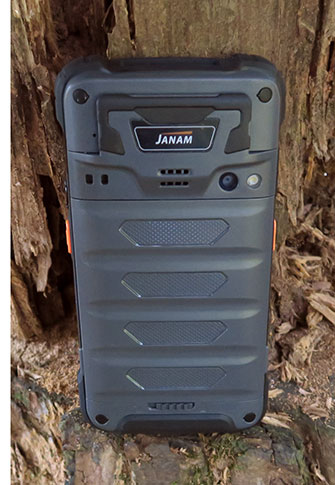 While the XT2 looks just like a regular smartphone from the front, you don't, of course get all of its extra features in a package that could be as thin and light as a modern phone. The extras here are a degree of ruggedness that is way, way beyond what any consumer smartphone can offer, and also the kind of connectivity and data collection technology only professional gear can provide. While the XT2 looks just like a regular smartphone from the front, you don't, of course get all of its extra features in a package that could be as thin and light as a modern phone. The extras here are a degree of ruggedness that is way, way beyond what any consumer smartphone can offer, and also the kind of connectivity and data collection technology only professional gear can provide.
The former includes IP67 sealing (dust- and waterproof) and a 5-foot drop specs. The latter includes an integrated industrial-grade SE4710 1D/2D barcode reader from Zebra. That's because on the job you don't scan inventory with the phone camera and an app. You do it with tech that was designed for fast, accurate, reliable scanning.
Then there are jobs that need RFID and NFC reading capabilities, or devices are going to be used as mobile payment stations in the field. That requires mag stripe readers. Bottom line is that today's and tomorrow's customers expect to find a full spectrum of data capture requirements in one single device. That's what Janam had in mind with the XT2.
Such a device also needs a big, replaceable battery, because out there in the field you can't just plug your tools in and wait until they are recharged. And since you never quite know how much data you may have to store, it's good to have a card slot. The Janam XT2 has both.
As a result, the Janam XT2 can't be razor-thin. It's about 0.9 inches thick and weighs about ten ounces. Which is still remarkably thin and light, but of course thicker and heavier than a consumer phone.
When the XT2 was initially launched in Spring 2016, Janam CEO Harry B. Lerner — a Harvard MBA and former Symbol Technologies executive — introduced the device as follows: "Enterprises are looking for smaller, lighter and faster mobile computers in order to deliver superior customer service and improve customer satisfaction. As sleek as a smartphone, Janam's tough XT2 is equipped with the most advanced technologies to meet the diverse needs of virtually any mobile worker."
Janam's approach with the XT2
Unlike Janam's XT1 mini-tablet which is between two types of devices — smartphones and tablets — the smaller XT2 is a true rugged handheld and not an in-between device. As such it must provide as much of the commonly expected consumer smartphone experience as possible, while also being much tougher than any standard smartphone, and equipped with the type of extra functionality required on the job (such as scanning, MSR, RFID, etc.)
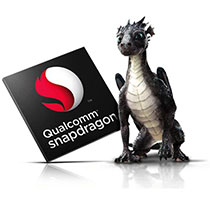 On the technology side of things, XT2 customers get a mix of consumer and industrial technology. The device is powered by a quad-core 1.2GHz Qualcomm MSM8916 processor that's part of the "Snapdragon" 410 line. It's a chip especially developed for embedded and smartphone applications. It uses a 64-bit CPU architecture and runs on four ARM Cortex A53 cores. On the technology side of things, XT2 customers get a mix of consumer and industrial technology. The device is powered by a quad-core 1.2GHz Qualcomm MSM8916 processor that's part of the "Snapdragon" 410 line. It's a chip especially developed for embedded and smartphone applications. It uses a 64-bit CPU architecture and runs on four ARM Cortex A53 cores.
For graphics, the MSM8916 includes an Andreno 306 GPU that supports all the features that matter in this class of mobile computer. The processor is used in numerous Samsung Galaxy, HTC Desire, Asus, Acer, Lenovo, Huawei and Motorola tablets and handhelds.
There are 2GB of RAM and 16GB of Flash for storage. While 16GB doesn't seem like a lot compared to iPhones that now come with up to 256GB, the XT2 has an internal, user-accessible microSDHC expansion card slot, which iPhones don't have. So the XT2 really has 16GB onboard plus whatever is in the card slot. That sometimes means users must copy things from here to there, or specify where something should be installed.
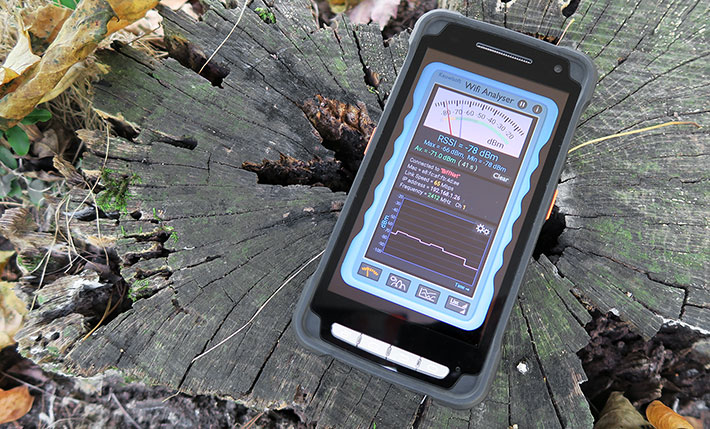
For communications there is dual-band 802.11a/b/g/n WiFi while many consumer devices still only offer single-band WiFi. With more and more WiFi access points offering both bands, we can say from experience that being able to take advantage of whatever is fastest and most reliable in a given location is a big plus.
Bluetooth is at the v4.0 (BLE) standard. BLE stands for Bluetooth Low Energy and refers to the fact that version 4.0 supports earlier versions of Bluetooth as well as the newer low energy protocols. It's a Class II implementation, which means a power rating of 2.5 milliwatts and an operating range of up to approximately 65 feet.
The Janam XT2 also comes with embedded NFC/RFID reading capability. Further, there's Qualcomm IZat Gen 8 support for concurrent GPS, BeiDou and GLONASS support. IZat supports location services that can show who and what is around the device, and whether it's indoors or out. Customers can specify 4G LTE, WCDMA, and EDGE/GPRS/GSM mobile broadband. An 8-megapixel autofocus camera with user-controllable LED flash can be used for both still image and video documentation, and there's also a 2mp frontfacing vidcam.
The Janam XT2 has a user-accessible and easily removable 11.1 watt-hour Li-Ion battery. A more powerful 14.8 watt-hour extended battery is optionally available. Charging is either via a supplied AC/DC charger or via Janam's single or multi device dock.
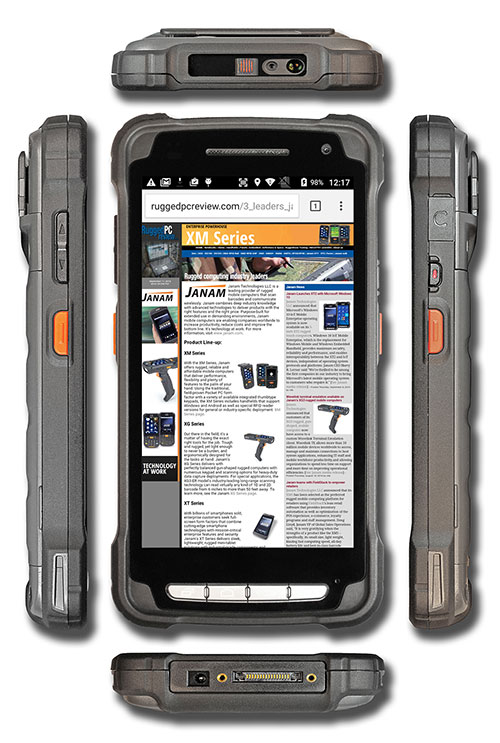 The compilation image below on the right shows the Janam XT2 from the front and from all four sides. The frontview shows the 5.0-inch screen with its hardened glass capacitive multi-touch interface. The compilation image below on the right shows the Janam XT2 from the front and from all four sides. The frontview shows the 5.0-inch screen with its hardened glass capacitive multi-touch interface.
The flush cover glass extends 1/8th inch beyond the LCD perimeter on the sides, and roughly half an inch on the top and bottom, making for smooth and easy operation. The glass is framed by a very slightly raised rubber border that serves both as a seal and to provide extra protection to the frontal glass.
On the top right is the user-facing camera lens. Unlike most lenses under cover glass, this one remains visible at all times, which makes it easier to look into the camera during video conversations.
The top view shows the unit's 1D/2D industrial-grade bar code reader window. Unlike in most handhelds equipped with dedicated scanners, the one in the XT2 does not add extra thickness. The slight "bulge" in the back shows the optional integrated MSR reader.
The left side of the device shows a volume up/down rocker as well as an orange scanner button. The right side has a second orange scanner button, the small on/off/sleep button, and the unit's 3.5mm audio jack beneath its protective sealing cover.
The bottom of the unit shows the surface-mount docking and USB connector and to the left of it the power jack. There is no standard micro-USB port; instead a special (and optional) USB sync cable is required. If you want to sync or connect with a desktop or laptop, do get the cable or the dock or both.
The XT2 has four physical buttons for the three standard Android controls (recent apps, home, and back), as well as a programmable key. The white labels on matte silver keys are not always easy to see.
Janam XT2: design and construction
Industrial handhelds have changed a very great deal over the past decade. Whereas once they were utilitarian and often very proprietary tools for narrowly defined jobs, today they are mobile computers, scanners, phones, cameras and more. However, unlike consumer smartphones and tablets that have become relatively short-lived throw-away or recyclable items, enterprise and industrial mobile devices have a much longer life cycle, and they must be easy to customize, configure, service and repair.
At RuggedPCReview.com, we want to know what's inside a unit that's expected to tirelessly and reliable do its job for years. We want to see if things inside are as clean and polished as a device looks from the outside. And we want to give prospective customers and users of the products we test the opportunity to see what they are getting.
So let's get started with the tour. The battery compartment of the Janam XT2 contains not just the battery, but also the unit's SIM and SAM slots, as well as the microSD card slot. This means it's open to the interior of the device, and that means the battery compartment cover must be very well sealed. Janam accomplished that with a cover design that uses a replaceable blue o-ring. It takes a bit of pressure to removed or re-insert the cover, which is securely held in place with a spring-loaded friction slider.
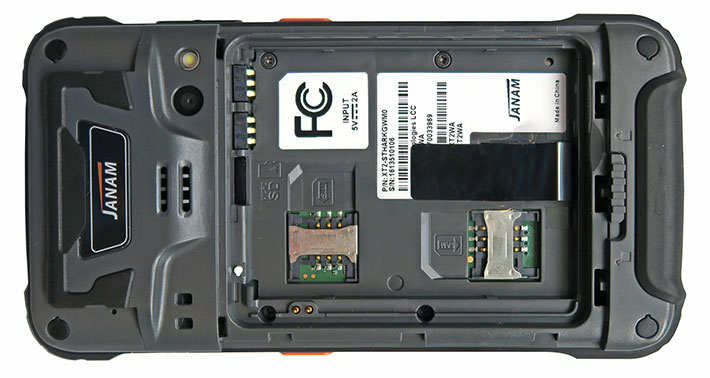
The rechargeable and obviously user-replaceable battery itself is a neat Janam-labelled 3.8 Volt, 3,000mAh Lithium-Ion design that amounts to 11.4 watt-hours. It's a thin pack not even a quarter of an inch thick.
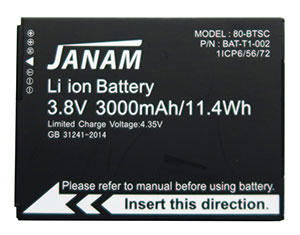 Above, I mentioned the SIM and the SAM card slot. Physically the two slots are the same, but where SIM (Subscriber Identity Module) is for voice and data wireless service, SAM stands for "Secure Access Module" and is really more like a SmartCard for devices that may be used to handle secure transactions, like mobile payments. Above, I mentioned the SIM and the SAM card slot. Physically the two slots are the same, but where SIM (Subscriber Identity Module) is for voice and data wireless service, SAM stands for "Secure Access Module" and is really more like a SmartCard for devices that may be used to handle secure transactions, like mobile payments.
Opening the housing of the Janam XT2 for repair or maintenance is fairly easy. Remove four little rubber plugs to get to the four Torx T8 screws sitting in the four corners of the device. Undo those, then undo the four smaller Philips head screws inside the battery compartment. Then you can carefully take the two halves of the housing apart. I say carefully because the various physical buttons are separate parts and fall out, and there's a delicate ribbon cable between the halves that connects the motherboard to the unit's MSR reader.
Sealing between the two halves is via a tongue-and-groove design with a thin rose-colored o-ring going around the entire perimeter. We like the use of color in such o-rings; it makes it much easier to see if they are uncompromised and in their proper place.
The two halves are each made of gray polymer plastic. Rubberized protective bumper material goes around the entire unit. The front part of the housing uses a aluminum or magnesium frame for stiffness and ruggedness. Mounted onto that frame are the display on one side, and the device's motherboard on the other. Virtually all of the circuitry is facing down onto the metal frame, presumably for thermal reasons.
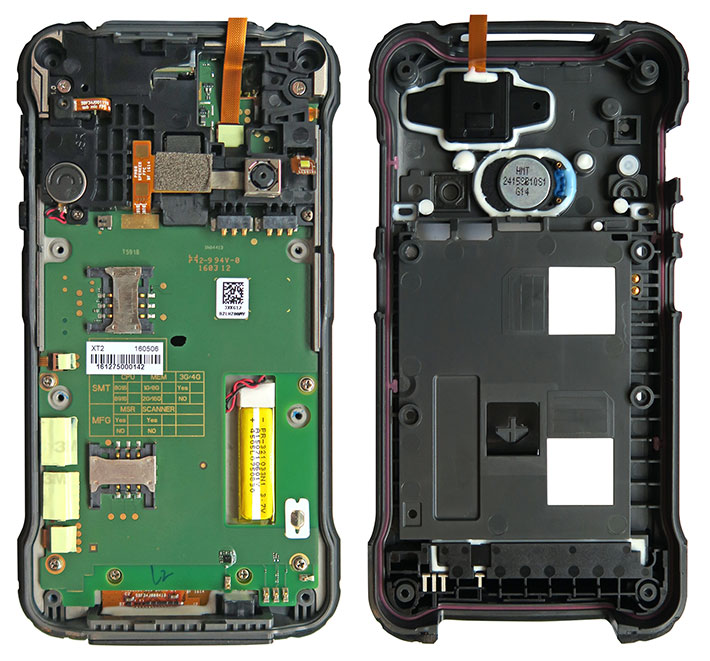
A small table is printed onto the board, informing whether the system is equipped with MSR, scanner, 3G/4G, how much RAM and how much storage memory, and if it's powered by a MSM8016 or an MSM8916 CPU. The difference between the two is that the MSM8916 includes an integrated 3G/4G LTE radio.
Visible is a small 3.7 Volt, 75 mAH backup battery and not much else. As is often the case in industrial handhelds, a plastic subframe holds, and serves as a mounting point for, all sorts of components. In the XT2 that means the camera, the LED flash, the scanner, and antennae. It's a neat, clean solution that provides an opportunity to admire just how small some of these components have become. You look, for example, at the tiny camera and even smaller LED flash and wonder how such a small assembly can do very good still images and video, and the little LED is much brighter than one might expect.
Overall, the whole interior design of the XT2 is impressive, as is the manufacturing. Fit and finish are on a very high level, everything looks well thought out, and there is great attention to detail. Even the white silicon glue that seals certain areas is applied cleanly and precisely (which isn't always the case in systems that come to our lab).
Below are a few interesting details from the inside of the Janam XT2. From left to right, there's a close-up of the replaceable pink rubber o-ring seal, the backside of the Magnetic Stripe Reader, and then the 8mp camera with its LED flash.

Very good 5-inch display and capacitive multi-touch
The 5.0-inch capacitive multi-touch display of the Janam XT2 is large enough to comfortably run the vast variety of apps available for modern Android devices. And it should also be spacious enough for emerging Windows 10 IoT Mobile Enterprise applications.
720 x 1280 pixel resolution translates into 294 pixels per inch. That's sharper than any of the retina iPads save one (the 7.9-inch mini retina), much sharper than any 4K TV or monitor or "retina" desktop, and also much sharper than Janam's own XT1 mini-tablet. It's not as much as the insanely high resolution of some of the premium consumer smartphones which are now approaching 600 ppi, but it's definitely super-sharp and very pleasant to work with.
The display is protected by chemically strengthened Gorilla Glass 3. As for brightness, Janam only says it's "exceptional," daylight-readable, and that it's also "anti-raindrop." The XT2 display also sports another quality that we consider very important: very good viewing angles from all directions. That means you don't have to hold the device just so in order to properly see what's on the screen. It looks the same no matter what angle you look at it from. There are also no color or contrast shifts, which is also very important when you work with color-coded apps.
The picture below show a comparison between the Janam XT2 and an iPhone 6 Plus outdoors, with both devices set to maximum screen brightness. Apple's big 6 Plus is said to have a maximum screen brightness of 550-600 nits. The XT2 specs don't include a nits rating, but under most conditions, it looks almost as bright. Both displays are glossy, so there are reflections outdoors. Most smartphone and tablet users have learned to live with that.

The XT2's tougher display, however, does come at a slight cost. Reflections are somewhat sharper, and there is a noticeable drop in perceived brightness when the display is viewed from angles. It does't affect colors, sharpness or contrast, just brightness.
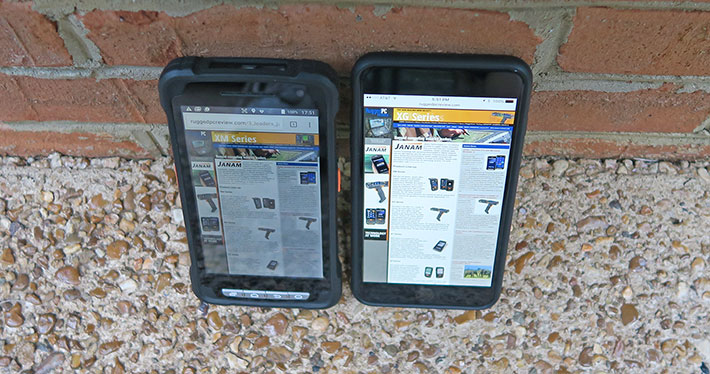
Android or Windows 10 IoT Mobile Enterprise
When our XT2 arrived at the RuggedPCReview lab in August 2016, the platform was based on Android 5.x "Lollipop." As of early September 2016, 35.5% of all Android devices are running Lollipop, the largest share of any of the Android version codenames. This means that the XT2 is exceptionally well supported on the software side, and should remain so for some time to come.
Unlike Janam's XM5 and XM70 handhelds that are offered with either Android or Windows Embedded Handheld, the XT2 initially was Android only. That made sense because in consumer markets, the vast majority of non-Apple smartphones and small tablets run Android. Even compared to Apple, Android has a commanding overall market share on small devices. And even though Windows Embedded Handheld managed to hold on in industrial markets for years after Microsoft essentially stranded the platform, Android is now making inroads in industrial devices as well.
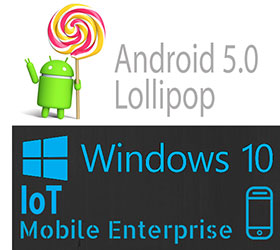 As a result, many providers of ruggedized handhelds now offer both Microsoft and Android based versions of their handhelds or are leaning towards Android. Janam itself stated that they offer whatever OS platform seems suited best for a certain device class and application; the company offers both Android and Windows (and yes, you can even still get Palm) in different models of its growing rugged device lineup. As a result, many providers of ruggedized handhelds now offer both Microsoft and Android based versions of their handhelds or are leaning towards Android. Janam itself stated that they offer whatever OS platform seems suited best for a certain device class and application; the company offers both Android and Windows (and yes, you can even still get Palm) in different models of its growing rugged device lineup.
As of early September 2016, the Janam XT2 became also available with Windows 10 IoT Mobile Enterprise. That requires some explanation.
First of all, why IoT (Internet of Things)? That's because Microsoft now calls everything that used to be "embedded" (like Windows Embedded Handheld) "IoT." That's because the industry expects billions and billions of smart, connected devices to handle more and more tasks over the next several years, and the great majority of industrial and embedded computers will be part of that overall Internet of Things.
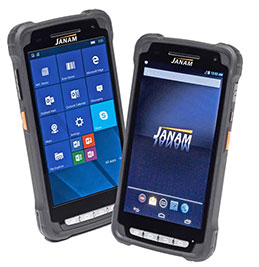 Another big change is the way Microsoft 10 works. The most important change is that with Windows 10, Microsoft offers what it calls a "unified core" that brings together conventional Windows, Windows Phone, Windows on Devices and even the Xbox. That doesn't mean there's just one Windows that runs on every type of device. Instead, the concept of Windows 10 is that of a common core with each family of devices, and then adding features to that core. Another big change is the way Microsoft 10 works. The most important change is that with Windows 10, Microsoft offers what it calls a "unified core" that brings together conventional Windows, Windows Phone, Windows on Devices and even the Xbox. That doesn't mean there's just one Windows that runs on every type of device. Instead, the concept of Windows 10 is that of a common core with each family of devices, and then adding features to that core.
In this new Windows world order, anything that needs a "modern" (formerly known as "metro") shell and must run mobile apps needs Windows 10 IoT Mobile Enterprise. This replaces the old Windows Mobile and Windows Embedded Handheld, and supports both the x86 and, with some caveats, the ARM architecture. One of the caveats is that for now, apparently, there's only support for certain Qualcomm processors.
Well, the Janam XT2 is based on a Qualcomm Snapdragon 410 MSM8916 processor, and that means Windows 10 IoT Mobile Enterprise can run on the XT2 without the need for different hardware. What impact that will have remains to be seen, as developers still have to get up to speed with all the whole Windows 10 infrastructure with its many variants. But Janam is absolutely to be congratulated for making it available.
Scanning and other data capture
While the Janam XT2 was created to be as handy and smartphone-like as possible, the device has considerably more sophisticated and powerful data collection capabilities. While most premium smartphones have cameras good enough to do simple scanning via apps, dedicated industrial-grade scanner modules are required for professional use. Same for mag card reading. There are third party readers that snap onto smartphones, but those are for light use only. The XT2, on the other hand, can be equipped with an integrated MSR reader that becomes part of the device. And Janam added demos that show how the various data collection and other advanced features work: GPS, MSR, NFC, Ping, Print, SAM and Scan.
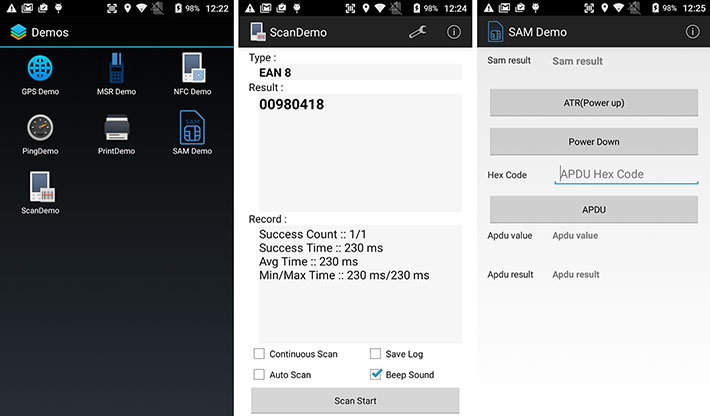
Scanning is likely of primary interest to many XT2 users. Our test unit came with an optional integrated industrial-grade miniature scan engine from Zebra. 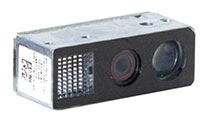 The SE4710 1D/2D imager (see SE4710 info) is tiny, measuring just 0.32 x 0.88 x 0.54 inches and weighing less than a fifth of an ounce, which is why there isn't a big scanner bulge on the XT2. The SE4710 1D/2D imager (see SE4710 info) is tiny, measuring just 0.32 x 0.88 x 0.54 inches and weighing less than a fifth of an ounce, which is why there isn't a big scanner bulge on the XT2.
The SE4710 has a red aiming LED and direct sunlight reading capability for easy use. It's quick, too, and can capture virtually any 1D or 2D bar code in milliseconds. Our XT2 came with a ScanSetting utility to configure the scanner for whatever job it's intended to be used. Below are some sample scan configuration screens:
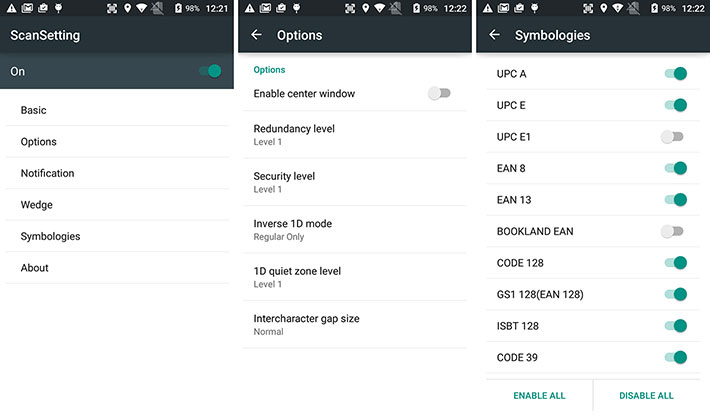
What all this means is that for XT2 customers, there's not only the proverbial "app for that," but also the dedicated hardware to make those data capture apps work at a professional level.
Competent cameras for documentation work
Nobody saw this coming, but smartphones have largely replaced dedicated point & shoot cameras, and they are increasingly being used for even advanced imaging projects. What that means is that today's professionals and field workers will expect their smartphone (or whatever handheld they are using) to be able to shoot pictures and video good enough to be used for their work. They won't want to take along a dedicated camera when they already have their handheld. Which means that devices like the XT2 must have cameras good enough for the job. That has become imperative.
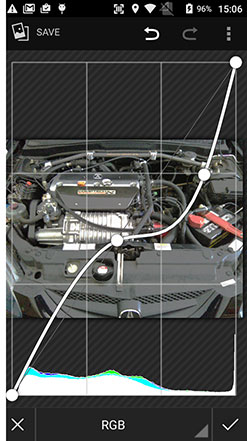 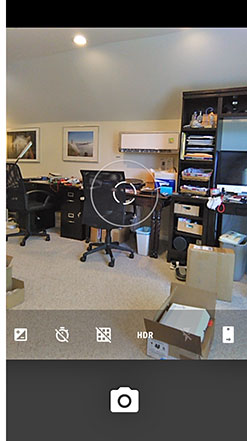 As expected, the XT2 has cameras in the front and the rear. The 2mp user-facing camera is for video calls. The rear-facing camera will likely be used for visual documentation of job conditions, repairs, project status and the like. Its maximum resolution is 8-megapixel, and it captures pictures with up to 3,264 x 2,448 pixel resolution. 8-megapixel is at the lower end of what you get in a premium smartphone, but it's plenty good enough, considering that 8mp resolution easily allows very acceptable 8.5 x 10 inch prints. Both cameras can be used for stills as well as for video. As expected, the XT2 has cameras in the front and the rear. The 2mp user-facing camera is for video calls. The rear-facing camera will likely be used for visual documentation of job conditions, repairs, project status and the like. Its maximum resolution is 8-megapixel, and it captures pictures with up to 3,264 x 2,448 pixel resolution. 8-megapixel is at the lower end of what you get in a premium smartphone, but it's plenty good enough, considering that 8mp resolution easily allows very acceptable 8.5 x 10 inch prints. Both cameras can be used for stills as well as for video.
In the past, we've been very underwhelmed with the performance of cameras integrated into rugged vertical market handhelds and tablets. A few years ago, even the best lagged way behind what was available in inexpensive point & shoots and consumer smartphones. Fortunately, this is now changing due to customer demand and the availability of much better camera modules for handhelds.
In our testing, we found the rear-facing documentation camera of the Janam XT2 to be remarkably competent. The test pictures we took with the device were absolutely suitable for most documentation tasks. Most shots came out fine on the first try, the camera was quick, color was good, and camera didn't over-compress images. It was also remarkably good at focussing on the right subject rather than wandering off.
The screen snap to the above left shows some of the camera settings screens, and what it looks like in picture-taking mode. The interface of the default Android camera is very basic, with just +/-2EV exposure control, three flash modes, and picture sizes from 1 up to 8 megapixels. It's possible that we overlooked something, but there wasn't anything obvious. Most users will want to download one of the many camera apps from the Google Play Store. We like Mark Harmann's free Open Camera app that works great on the XT2.
Interestingly, the on-device image editing capabilities via Photo Editor are significantly more elaborate (see screen snap above right). There is a wealth of functions available, including color effects, frames, cropping, straightening, mirroring, numerous filters, and even such advanced operations as sharpening, hue, vibrance and curves (see example to the right). Here again, should more be needed — such as social media, messaging and email support — that's available via 3rd party apps.
The pictures below were shot with the Janam XT2 in 8mp mode. Click on the image to bring up a full-size version.

What's important here is that the rear camera of the XT2 is good enough to use for image and video documentation on the job. Most won't need to take a long a dedicated camera. There is good sharpness and image detail, and the focus is quick enough and quite precise. And, thankfully, there's little of the massive image compression that often renders pictures from such integrated cameras useless.
Video is also significantly better than what one could expect from cameras integrated into rugged devices just a year or two ago. Frame rate and focussing are quick and the camera doesn't fall behind. The maximum 1920 x 1080 (1080p) recording format worked flawlessly. 720p and 480p formats are available as well.
The video sample clip to the right was taken with the Janam XT2 camera.
Note again that the camera applications that come with mobile operating systems are often replaced with third party applications optimized for certain tasks, or developers and systems integrators include camera and video functionality directly into custom applications. In addition, the Google Play store has numerous camera applications that are either free or very inexpensive. We highly recommend using one of those.
Overall, the still image and video quality of the Janam XT2 are much better than average and definitely good enough for most documentation jobs.
Truly tough and rugged
Ruggedness is what separates devices specifically designed to withstand the perils and conditions of work out there in the field from consumer smartphones. Yes, consumer phones can be stuck into a protective case or even into a sleeve that adds functionality, like a bigger battery or a dedicated scanner. But those are generally half-baked solutions that may or may not get the job done. Leading smartphone manufacturers are catching on to the need for better protection now, at least to a certain extent. But making a handheld a bit more resistant to liquids is still far from being rugged.
True ruggedness comes at a cost. Extra components cost, extra protection costs, and the result will be thicker and heavier than a consumer product. Yet, in order to appeal to customers used to slender, glossy smartphones, the ruggedized handheld must still be attractive enough to be accepted, and light and handy enough not to get in the way.
So what degree of ruggedness did Janam bake into their rather attractive XT2? We already reported on build quality and structural design. But what about this handheld's ruggedness specifications?
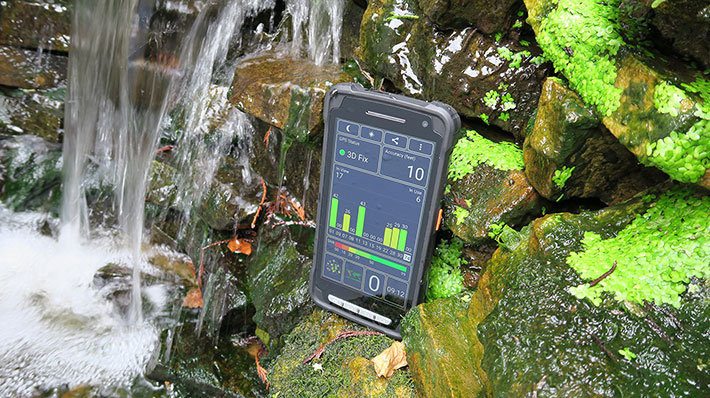
First, the Janam XT2 carries IP67 sealing where the "6" means it is totally protected against dust, and the "7" means that it is also protected against the effects of full immersion in water down to a depth of one meter (3.3 feet). That makes the XT2 invulnerable to dust and liquids. It can be used the rain, even in a down-pour. And if it falls into a puddle or even a shallow stream, no problem.
Note, of course, that capacitive multi-touch and water generally don't get along because the technology relies on measuring capacitance between touches. Janam addressed that to some extent with a display surface that makes liquids pearl into tiny drops, making multi-touch possible even in the rain. Gloves are another problem with capacitive multi-touch, but the XT2's touch controller is sensitive enough to allow working with thin gloves.
The pictures above and below show that in our tests, the XT2 had no problems with water at all. Water spray on it didn't interfere with operation, and even dunking it into water never made it miss a beat.
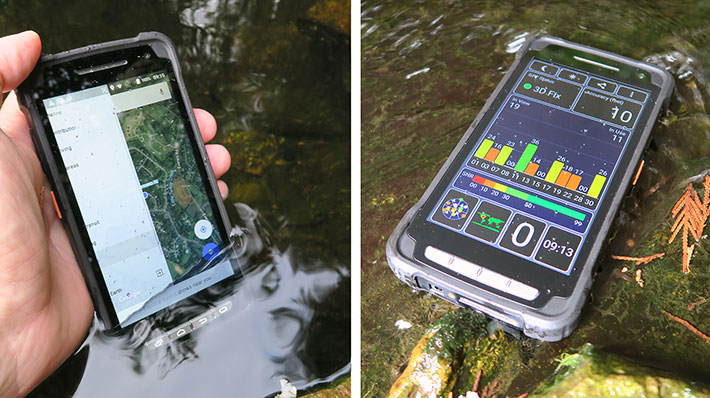
The device can handle multiple drops from five feet to concrete. When it comes to mobile computers that are used while being carried around — such as tablets and handhelds — you want for them to be able to survive drops of four feet, because that is about as far as they'll fall. You also want for them to survive those falls no matter what they hit and in what position they make impact. And no matter how hot or cold it is. The XT2 was tested for all that.
 The unit's operating temperature range of -4 to 140 degrees Fahrenheit (-20 to 60 degrees Celsius) is wide enough to allow the device to be used almost anywhere. That's important because mobile devices may encounter very high temperatures in vehicles or sitting in the sun, or very low ones if they are inadvertently left in an unheated environment. The unit's operating temperature range of -4 to 140 degrees Fahrenheit (-20 to 60 degrees Celsius) is wide enough to allow the device to be used almost anywhere. That's important because mobile devices may encounter very high temperatures in vehicles or sitting in the sun, or very low ones if they are inadvertently left in an unheated environment.
Janam specs also state vibration testing at an amplitude of 2MM from 10Hz to 33Hz in all three axes, one hour per axis, but there's no reference to which tests were performed (in general, MIL-STD-810G, Method 514.5 is used for vibration testing). It'd be good to know specifics. In addition, we've found YouTube videos of the device being subjected to extreme abuse, with no adverse effects.
Our overall impression is that the Janam XT2 is designed to withstand extreme environmental conditions without additional protection or fear of failure.
Summary: Janam XT2 — well-executed smartphone-style rugged touch computer
Overall, what does all that make the Janam XT2? Unquestionably an attractive choice for any enterprise seeking to deploy and manage smartphone-style handhelds with industrial durability and extensive data collection technology.
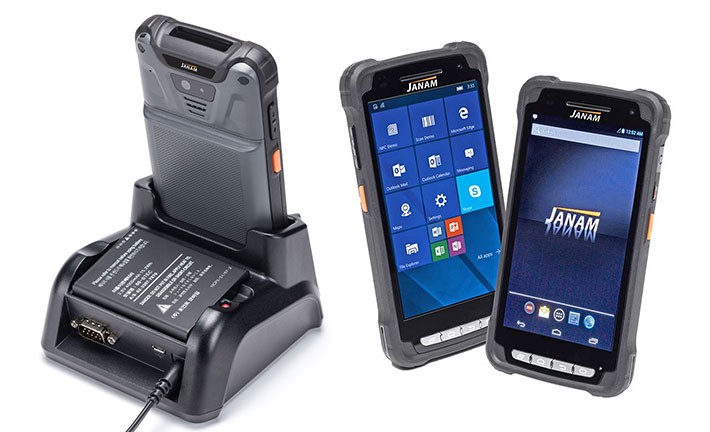
Like all of Janam's mobile computing hardware, the XT2 is a device that caters to the needs of customers who use their devices at and for work. That means ruggedness and durability that goes far beyond what consumer smartphones can offer. It means industrial-grade components such as an integrated Zebra 1D/2D barcode reader module rather than just using the internal camera with a scanner app as consumer devices usually do.
The bright 5.0-inch capacitive multi-touch display of the Janam XT2 offers enough screen real estate for even complex applications, and it's plenty sharp enough. The device is thicker and heavier than consumer phones, but most people can easily hold and use it in one hand. But at just under 10 ounces it's still light enough to be used and carried around all day long. The battery is replaceable, which is always good in a device used in the field.
There's integrated GPS, NFC/RFID reading, and optional mag stripe reading and mobile broadband. There's the integrated industrial-grade 1D/2D imager for bar code reading. The dual cameras (8mp and 1.2mp) work very well and are easy to use. USB connectivity does require the optional cradle or proprietary USB sync cable.
The device is elegant, well designed, and meticulously finished. It's also fully rugged and carries IP67 sealing, which means it won't even mind a drop into a puddle or stream.
Initially only available with Android, Janam now also offers the XT2 with Windows 10 IoT Mobile Enterprise. This considerably widens the device's application potential in any area that requires, in Janam's words, business-class performance, durability and flexibility in a smartphone-like design.
-- Conrad H. Blickenstorfer, September 2016
Janam XT2 Specifications:
| Added/changed |
Added 03/2016, full review 09/2016, updated 09/2018
|
| Type |
Rugged handheld
|
| Processor |
1.20GHz Quad-core Qualcomm MSM8916
|
| Graphics |
Adreno 306 GPU
|
| OS |
Android 5.x Lollipop (tested) or Windows 10 IoT Mobile Enterprise
|
| Standard/Max RAM |
2GB RAM |
| Disk/drive |
16GB ROM onboard, plus microSDHC card storage (up to 64GB) |
| Display type |
TFT LCD with Gorilla Glass 3, outdoor-viewable |
| Display size/resolution |
5.0" WXGA (1280 x 720 pixel) |
| Display luminance |
RuggedPCReview measured: 456 nits |
| Digitizer |
Projected capacitive multi-touch |
| Keyboard/keys |
Onscreen keyboard, 4 hard keys (home, menu, back, user-programmable)
|
| Navigation |
Touch
|
| Expansion slots |
1 x microSDHC Card (user-accessible), 1 X SIM
|
| Housing |
Unknown
|
| Size |
6.1 x 3.2 x 0.9 inches (155 x 83 x 24 mm)
|
| Weight |
9.8 oz (280g) incl. battery and MSR
|
| Operating temperature |
-4° to 140°F (-20° to 60°C) |
| Ingress protection |
IP67 (totally protected against dust; protected against full immersion to 1 meter) |
| Humidity |
95% non-condensing |
| Drop |
Multiple 5ft / 1.5m drops to concrete on all sides across a wide temperature range per MIL-STD 810G |
| Vibration |
2MM from 10 to 33Hz in all three axes, 1 hr/axis |
| Radio |
FCC; IC; GCF & PTCRB; CE |
| Safety |
CSA C22.2 No.60950-1-03; EMC; RF; SAR; LED |
| Tumble |
500 cycles (1,000 hits) from 1 meter (3.3 feet) |
| ESD |
+/-15kV air; +/-8kV contact |
| Intrinsic safety |
NA |
| Power |
3.7V, 3,000mAh rechargeable Li-Ion battery (4,000mAH optional); 3.7V, 75mAH backup battery |
| Data capture |
Zebra SE4710 1D/2D imager, MSR, RFID/NFC |
| Camera |
front-facing: 2.0mp Galaxy Core GC2355; rear-facing: 8.0mp Samsung S5K4H5 auto-focus with user-controllable LED |
| GPS |
Qualcomm IZat |
| Sensors |
G-sensor, accelerometer, ambient light, proximity |
| Wireless |
Dual-band 802.11 a/b/g/n WiFi, Bluetooth v4.0, WWAN (4G LTE, WCDMA, EDGE/GPRS/GSM), GPS and A-GPS |
| Interface |
USB 2.0, 3.5mm audio in/out |
| Price |
Inquire |
| Spec sheet |
 Janam XT2 brochure (PDF) Janam XT2 brochure (PDF)
|
| Web page |
Janam XT2 web page |
| Contact |
Janam
100 Crossways Park West
Woodbury, NY 11797
1-877-JANAM-99
www.janam.com
|
|






